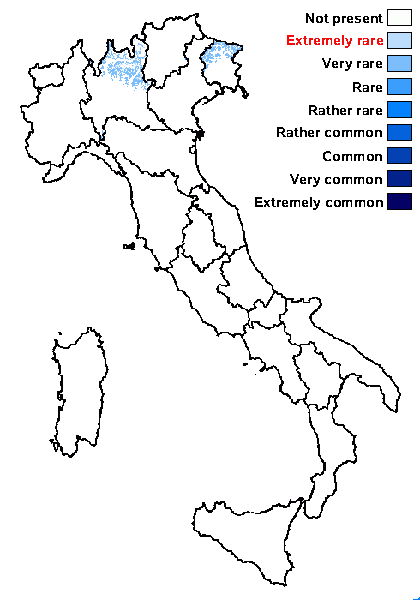Chaenothecopsis viridireagens (Nádv.) A.F.W. Schmidt
Mitt. Staatsinst. allg. Bot. Hamburg, 13: 153, 1970. Basionym: Calicium viridireagens Nádv. - Preslia, 18/19: 129, 1940.
Synonyms:
Distribution: N - Frl (Puntillo & Puntillo 2009, Brackel 2016), Lomb (CLU 13118).
Description: Thallus not evident, not lichenized. Apothecia long-stalked, pin-like, 0.5-1.4 mm high, the stalk 0.04-0.07 mm thick, black, sometimes with a reddish tinge in upper part, the central part of hyaline, strongly swollen, periclinally arranged hyphae, the outer part of reddish brown, intricately interwoven hyphae, often containing droplets of a red pigment. Capitulum black or with a reddish tinge in lower part, hemi- to subspherical, 0.1-0.3 mm across; mazaedium absent. Exciple of reddish brown hyphae; epithecium brownish, thin; hypothecium reddish to yellowish brown, with dark red granules and numerous oil droplets. Asci 8-spored, cylindrical, with a thickened apex penetrated by a narrow canal, formed singly, persisting until the spores are mature. Ascospores 1-septate, pale brown, narrowly ellipsoid, 5-7 x 1.5-2.5 µm, with a poorly pigmented septum and a smooth wall. Pycnidia not rare, stalked, the stalk often branched and forming a tree-like structure with up to 30 pycnidia containing a reddish pigment. Conidia simple, hyaline, with a slightly truncate proximal end, 2-2.5 x c. 1 µm. Photobiont absent. Spot tests: all red-pigmented parts of thee ascomata and pycnidia K+ persistently green. Chemistry: an unidentified red pigment. Note: a mainly boreal-montane, perhaps circumpolar species found on decorticated stumps, occasionally on acid bark inside montane and subalpine forests on the thalli of Chaenotheca- and Calicium-species; probably more widespread, but never common, in the Alps.
Growth form: Lichenicolous fungus
Substrata: bark and lignum
Reproductive strategy: mainly sexual
In underhangs rarely wetted by rain
paras Chaenotheca and Calicium spp.?
Commonnes-rarity: (info)
Alpine belt: absent
Subalpine belt: extremely rare
Oromediterranean belt: absent
Montane belt: very rare
Submediterranean belt: absent
Padanian area: absent
Humid submediterranean belt: absent
Humid mediterranean belt: absent
Dry mediterranean belt: absent

Predictive model
Herbarium samples
Growth form: Lichenicolous fungus
Substrata: bark and lignum
Reproductive strategy: mainly sexual
In underhangs rarely wetted by rain
paras Chaenotheca and Calicium spp.?
Commonnes-rarity: (info)
Alpine belt: absent
Subalpine belt: extremely rare
Oromediterranean belt: absent
Montane belt: very rare
Submediterranean belt: absent
Padanian area: absent
Humid submediterranean belt: absent
Humid mediterranean belt: absent
Dry mediterranean belt: absent

Predictive model
| Herbarium samples |
 INDEX FUNGORUM
INDEX FUNGORUM
 GBIF
GBIF
 DOLICHENS
DOLICHENS


